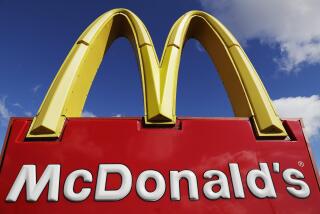Healthy food doesn’t have to be expensive, USDA insists
- Share via
Healthy food, we’ve often heard, is pricey food. Fruits and vegetables -- they’re expensive! We can’t afford to eat that way! That’s why we don’t do it!
The U.S. Department of Agriculture wants us to understand that this isn’t the case, and held a news conference Wednesday to report the results of a study that examined the matter.
Study lead author Andrea Carlson from the USDA’s Economic Research Service presented the 50-page report, entitled “Are Healthy Foods More Expensive? It Depends On How You Measure the Price.”
Carlson explained that most studies measure the prices of groceries based on price-per-calorie. And when prices are computed that way, sure enough, items like broccoli do end up being more expensive than the likes of maple-glazed donuts. What about that?
(It may just be me, but isn’t it a little astounding that analyses are generally done this way? Calories are not what most Americans lack.)
Carlson and her colleague, Elizabeth Frazao, calculated food costs the price-per-calorie way and two additional ways.
One method -- price per edible weight -- calculated price based on the weight of food once it was all prepared (that is scaled, seeded, hulled, bones removed, cooked, etc.).
A third way was price per average amount -- meaning how much people actually eat of a food. (You could see how broccoli would end up being a heck of a lot cheaper than maple-glazed donuts if prices were calculated this third way.)
They used a database of more than 4,000 food items and sorted them into several groups: the five USDA food groups -- grains, dairy, fruit, vegetables or protein foods -- as well as mixed dishes and “less healthy” items. Less-healthy foods had too much saturated fat, sodium or added sugars or were just generally lacking, five-food-group-wise. (Interestingly, a lot of canned soups as well as fruit-flavored yogurt fell into that group.)
“If we use price per calorie, fruits and vegetables tend to be more expensive than less healthy food,” Carlson wrote on the USDA blog. “If we use price per edible weight or per average amount eaten, then grains, vegetables, fruits and dairy foods are less expensive than most protein foods and less healthy foods.”
The research “challenges the widely held belief that ‘Gee, I just can’t eat healthily affordably,’ ” commented Kevin Concannon, USDA undersecretary for food, nutrition and consumer services.
It is still true that the USDA’s vegetable recommendation is the most expensive to meet because we’re meant to eat a whole bunch of vegetables, Carlson notes. (The recommendation depends on your age and level of physical activity: I just calculated mine and I should eat 1.5 cups of fruit and 2.5 cups of vegetables a day. Try computing your own.)
But there are always ways to eat cheaply and healthily just by choosing the right foods, Carlson said. Cabbage, onions and beans come to mind.
Some may protest that the cheap-eating methods involve skills beyond the current ability of many Americans because cooking is a lost art. Carlson says culinary cluelessness should be no barrier. Fresh fruit? Wash and eat. Beans? Defrost, or open a can. “I know cooking skills are lacking but I think we can still use a can opener,” she said.
Perhaps the bigger issue is what people actually like to eat. A burger and fries or a whole mess of cabbage and beans? “My study doesn’t really cover what consumers value, but we do know from other studies that taste is the first thing that people consider … taste and convenience,” Carlson said.
News conference participants noted that there are a variety of tools on the USDA website to help people eat well on a shoestring.
And check out these thrifty-eating tips compiled by freelance writer Karen Ravn for a previous L.A. Times article.
More to Read
Eat your way across L.A.
Get our weekly Tasting Notes newsletter for reviews, news and more.
You may occasionally receive promotional content from the Los Angeles Times.










